Essential recording for a Stravinsky library
Keith Peters | 06/29/2000
(5 out of 5 stars)
"Igor Stravinsky proves in these recordings that he was a master conductor of his own music. The Pulcinella complete ballet has never sounded so vibrant. The Symphony in C is crisp and energetic with its fourth movement final chorale very poignant. Add the Octet, the Tchaikovskian Fairy's Kiss, and the suite from L'Histoire and you have two very full discs of authoritative Stravinsky. Sony has taken these gems from the early to mid 50s Columbia Masterworks Catalog, remastered the Severance Hall recordings,and has put an excellent package around it. Tim Page may be one of the best writers on music around and these liner notes are no exception. The mono sound is perfectly serviceable. Get this one quick!"
Excellent examples of Stravinsky as conductor, in fine remas
Santa Fe Listener | Santa Fe, NM USA | 01/24/2009
(5 out of 5 stars)
"This collection of Stravinsky's monaural recordings for Columbia Records is out of print and very expensive, so it might help for the prospective buyer to know exactly what lies in store.
CD 1 and half of CD 2 derive from sessions with the Cleveland Orch. in Dec. 1955. The works are The Fairy's Kiss, Sym. in C, and Pulcinella (complete with vocal soloists, in this case local Clevelandrs, I believe). CD 2 is rounded out with the L'Histoire du Soldat Suite and the Octet, derived from sessions in Jan. 1954 in New York. The small ensemble consists of outstanding freelances and members of the NY Phil. They are recorded cearly and very close up.
The Cleveland recordings re in spacious, detailed monaural sound that has remastered very well; these could be mistaken for modern recordings. Stravinsky made very good stereo remakes of the Sym. in C and Pulcinella, but the earlier versions are tidier and better played. The composer was somewhat less fierce in the Sym. in C in 1955. A deciding factor in Pulcinella might be that the vocal soloists in the later, stereo version are so much better -- the Cleveland singers really struggle at times.
His remakes of The Fairy's Kiss and L'Histoire weren't nearly as good as these early accounts, however, in terms of rhythmic vigor and ensemble.
Which leaves the Octet. I haven't listened to the stereo remake recently - I did audition all the others -- but this early one is exceptionally good, and with a small chamber group it hardly matters that it's in mono.
In the final analysis, everything on these two CDs shows Stravinsky the conductor at his best. I assume that the sellers at Amazon are offering the deluxe packaaging of the original releases on Masterworks Heritage -- at these prices, they should be."
The fusion of two composers through the times!
Hiram Gomez Pardo | Valencia, Venezuela | 08/10/2005
(5 out of 5 stars)
"Pulcinella: a "ballet with songs" in one act and eight scenes, was composed in 1919-1920. The relation between both composers Pergolesi and Stravinsky is far from being obscure. There's an admirable blending process: The instrumentation is purely Stravinsky and the melodies are all by Giovanni Baptista. Even the forms of the individual pieces sometimes have been lifted whole and without change from Pergolesi, but other times they have been expanded or remodeled to a very considerable degree.
Stravinsky remembers the production of Pulcinella at the Paris opera in 1920, as one of his most theatrical experiences. Imagine the prodigious spectacle: scenery and costumes by Picasso and Ernest Ansermet conducting: A true God's dish.
In this recording we have to the composer in front of one of the most dynamical orchestras at that special moment. Recorded in December 14, 1953, Severance Hall, Cleveland.
The exquisite cast included Mary Simmons, Soprano, Glenn Schnittke, Tenor and Phillip MacGregor, Bass.
The kiss of the fairy has other superior readings such Ansermet Suisse Romande for instance and I guess The Symphony in C is interesting but without dazzling spirit.
But the collection is important for all hard collector that wishes to follow the traces of the music in the XX Century.
A historical issue all the way.
"


 Track Listings (14) - Disc #1
Track Listings (14) - Disc #1



